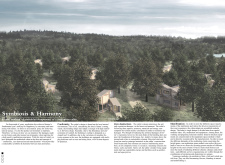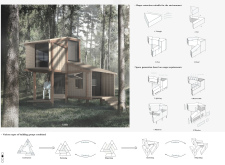5 key facts about this project
Unique Design Approaches
One of the distinctive features of "Symbiosis & Harmony" is its modular construction method. The cabins utilize prefabricated elements, which allow for efficient assembly and disassembly. This approach not only enhances flexibility but also minimizes construction waste and the ecological footprint of the project. The design incorporates a range of sustainable materials, primarily recycled wood, which contribute to the overall functionality while maintaining a harmonious aesthetic with the environment. The inclusion of steel in structural components ensures durability while maintaining a lightweight design.
The geometrical configuration of the cabins is also noteworthy; triangular shapes are employed to enhance stability against environmental forces while facilitating natural light penetration through strategically positioned windows. These design considerations help to create intimate, visually connected spaces that promote a sense of calm and connection with nature.
Spatial Arrangement and Functional Design
The architectural layout of the cabins features multi-functional spaces designed for versatility. Each cabin includes zones for meditation, relaxation, and communal interaction. The open floor plan facilitates movement and interaction among users while providing private areas for individual contemplation. The incorporation of elevated platforms and terraces allows users to appreciate the natural landscape, further enhancing the spatial experience.
Rainwater collection systems integrated into the sloped roof design exemplify the project's commitment to sustainable practices. This feature not only supports water conservation efforts but also reflects an innovative approach to resource management within the architectural framework. Detailed diagrams and architectural sections illustrate the construction and assembly processes, offering valuable insights into the project's technical execution.
In summary, "Symbiosis & Harmony" exemplifies an architecture that prioritizes sustainability, adaptability, and integration with nature. Its emphasis on modularity and the careful selection of materials contribute to a design that is both functional and environmentally conscious. For a deeper understanding of the project, including architectural plans, sections, and additional design details, readers are encouraged to explore the project presentation.


























